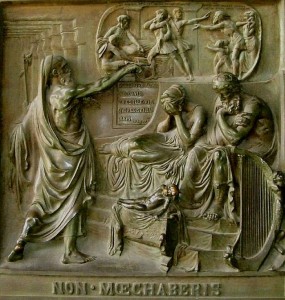Does a passage in the Bible only mean what it meant in its original context to its original author?
 Yes and no. Context is essential for understanding what the Bible means. Take for example a sermon I once watched on YouTube that was preached by a pastor the Sunday after news broke that he had been in an affair. His text for the morning was, “Nathan said to David, ‘You are the man!’” In this sermon the preacher claimed the text to be a word from God that he was the man to keep the church going, and therefore he was not going to step down. The sad part about this sermon is that Nathan’s words to David were words of judgment. Nathan had just finished telling a parable about a king who abused his power. Nathan was confronting David as the man in that story who had abused his power by committing adultery with Bathsheba and murdering her husband, Uriah. When we say today, “You are the man!” we usually mean it as a compliment of a man’s ability or prowess. But the phrase, “You are the man,” did not mean to Nathan and David what it means in today’s vernacular or slang, but rather was a simple statement of fact about David being the man in Samuel’s parable who abused his power. To use it as a word from God about a pastor’s ability or prowess in the face of marital infidelity is almost to call down upon oneself double judgment! The pastor was seemingly unknowingly claiming that he was the man who was abusing his power! Context is essential.
Yes and no. Context is essential for understanding what the Bible means. Take for example a sermon I once watched on YouTube that was preached by a pastor the Sunday after news broke that he had been in an affair. His text for the morning was, “Nathan said to David, ‘You are the man!’” In this sermon the preacher claimed the text to be a word from God that he was the man to keep the church going, and therefore he was not going to step down. The sad part about this sermon is that Nathan’s words to David were words of judgment. Nathan had just finished telling a parable about a king who abused his power. Nathan was confronting David as the man in that story who had abused his power by committing adultery with Bathsheba and murdering her husband, Uriah. When we say today, “You are the man!” we usually mean it as a compliment of a man’s ability or prowess. But the phrase, “You are the man,” did not mean to Nathan and David what it means in today’s vernacular or slang, but rather was a simple statement of fact about David being the man in Samuel’s parable who abused his power. To use it as a word from God about a pastor’s ability or prowess in the face of marital infidelity is almost to call down upon oneself double judgment! The pastor was seemingly unknowingly claiming that he was the man who was abusing his power! Context is essential.
 But context is not the final key. Recently I read an article by a professor of mine at Duke, David Steinmetz, who suggested that the Bible is like a mystery novel (The Art of Reading Scripture). You read through the novel and you get all kinds of little details in it that don’t seem to be of any importance. This is the long narrative in the story, but at the end when the brilliant detective figures out the mystery, she usually tells a much briefer narrative that provides the key for the reader to reinterprets all the smaller details that came in the longer narrative. In a couple of paragraphs the reader’s interpretive lenses are swapped with new ones, and the reader now reads the story from back to front instead of from front to back. The reader sees things in the longer narrative that now have two or three or more meanings. Those details usually foreshadowed the final conclusion but did not fully develop it.
But context is not the final key. Recently I read an article by a professor of mine at Duke, David Steinmetz, who suggested that the Bible is like a mystery novel (The Art of Reading Scripture). You read through the novel and you get all kinds of little details in it that don’t seem to be of any importance. This is the long narrative in the story, but at the end when the brilliant detective figures out the mystery, she usually tells a much briefer narrative that provides the key for the reader to reinterprets all the smaller details that came in the longer narrative. In a couple of paragraphs the reader’s interpretive lenses are swapped with new ones, and the reader now reads the story from back to front instead of from front to back. The reader sees things in the longer narrative that now have two or three or more meanings. Those details usually foreshadowed the final conclusion but did not fully develop it.
The Bible works the same way. The final shorter narrative is what Paul has summarized saying:
For I handed on to you as of first importance what I in turn had received: that Christ died for our sins in accordance with the scriptures, and that he was buried, and that he was raised on the third day in accordance with the scriptures (1 Cor 15:3-4, NRSV).
 Notice that he says it was “of first importance” and that it was “according to the scriptures.” In other words, you won’t get the rest of the story if you don’t get this key part of it. This is the key that unlocks the mystery. This is Holmes at the end of the story showing Watson how it all worked in the background. The shorter story of Jesus life, death, and resurrection makes the reader go back and do a double take of everything that they have read up to that point. The reader then sees things in the longer story that were not apparent in the first reading from front to back. All of a sudden, for example, when God says, “Let us make man in our image,” we begin to see that the “us” and “our” probably meant God amidst the heavenly company of angels for the original author and original context, but now we see that it is a reference to the Trinity: Father, Son, and Holy Spirit.
Notice that he says it was “of first importance” and that it was “according to the scriptures.” In other words, you won’t get the rest of the story if you don’t get this key part of it. This is the key that unlocks the mystery. This is Holmes at the end of the story showing Watson how it all worked in the background. The shorter story of Jesus life, death, and resurrection makes the reader go back and do a double take of everything that they have read up to that point. The reader then sees things in the longer story that were not apparent in the first reading from front to back. All of a sudden, for example, when God says, “Let us make man in our image,” we begin to see that the “us” and “our” probably meant God amidst the heavenly company of angels for the original author and original context, but now we see that it is a reference to the Trinity: Father, Son, and Holy Spirit.
Christians who came before us sometimes spoke of the fourfold sense of scripture. Any passage or story might have four different ways of being understood. Those four ways are:
- Literal – what happened,
- Allegorical – what you should believe,
- Moral – what you should do,
- Mystical – where you should go.
 The original author or context might not have known or understood all four of these meanings, and they may not have become evident until the end of the story when Jesus arrives on the scene. In fact, we may not even see for ourselves all the possible meanings of any given passage or text. Right now we are living in the fourth act of a five act play. Act I: God created and humanity messed things up. Act II: God creates the nation of Israel to begin to repair things. Act III: Jesus is the culmination of God’s repair job. Act IV: Jesus creates the church to continue that repair job. Act V: Jesus comes back again. When Jesus comes back again, we may once more see things differently than we saw them before. We may notice parts of our own story that we hadn’t noticed before. Those parts of our own story may even take on new meanings that were not apparent even to ourselves. Context is essential, but context is not the final key. Only Jesus is key.
The original author or context might not have known or understood all four of these meanings, and they may not have become evident until the end of the story when Jesus arrives on the scene. In fact, we may not even see for ourselves all the possible meanings of any given passage or text. Right now we are living in the fourth act of a five act play. Act I: God created and humanity messed things up. Act II: God creates the nation of Israel to begin to repair things. Act III: Jesus is the culmination of God’s repair job. Act IV: Jesus creates the church to continue that repair job. Act V: Jesus comes back again. When Jesus comes back again, we may once more see things differently than we saw them before. We may notice parts of our own story that we hadn’t noticed before. Those parts of our own story may even take on new meanings that were not apparent even to ourselves. Context is essential, but context is not the final key. Only Jesus is key.

Recent Comments